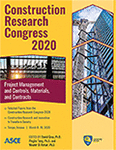Construction Research Congress 2020
Environmental Implications of Quarry Rock Dust: A Sustainable Alternative Material to Sand in Concrete
Publication: Construction Research Congress 2020: Project Management and Controls, Materials, and Contracts
ABSTRACT
Sand is a vital natural resource of our ecosystem, yet the construction industry is threatening its availability. Excessive mining of sand imposes adverse effects on our environment, and this problem is becoming extremely severe as it is exposing the river ecosystem and endangering marine biodiversity across the world (i.e., Tamil Nadu in India, Poyang in China, and California in the United States). Quarry rock dust (QRD), a waste obtained during the quarrying process is a significant source of air pollution yet has the potential of becoming a sustainable and economical alternative to sand in concrete. Studies confirmed that replacing sand in conventional concrete with QRD increases its durability and robustness by ten percent. The objective of this study is to determine QRD’s environmental implications through carbon footprint analysis. To achieve this, the research utilizes one of the very few case studies of Barbados Quarry site that produces more than 35,000 tons of aggregates per month and 500,000 tons of QRD is produced as a by-product. This research prepares a preliminary life cycle analysis of QRD, its carbon dioxide emissions as well as the economical analysis of QRD. The findings of this study promote the use of QRD considering its less environmental impact in comparison to sand when used in concrete. The study also encourages a paradigm shift in concrete practices, which not only paves for a more resilient alternative to concrete but also a more sustainable construction process.
Get full access to this article
View all available purchase options and get full access to this chapter.
REFERENCES
Ahuja, H. N., Dozzi, S. P., and AbouRizk, S. M. (1994). Project management : techniques in planning and controlling construction projects. J. Wiley.
Ashraf, M. A., Maah, M. J., Yusoff, I., and Wajid, A. (2011). “Sand mining effects, causes and concerns : A case study from Bestari Jaya, Selangor, Peninsular Malaysia.” Academic Journals, 6(6), 1216–1231.
Devi, M., and Kannan, K. (2011). “Strength and Corrosion Resistive Properties of Concrete Containing Quarry Dust as Fine Aggregate with GGBFS.” Advanced Materials Research, Trans Tech Publications, 243–249, 5775–5778.
ElZomor, M., Burke, R., Parrish, K., and Gibson, G. E. (2018). “Front-End Planning for Large and Small Infrastructure Projects: Comparison of Project Definition Rating Index Tools.” Journal of Management in Engineering, 34(4), 04018022.
EPA. (1990). AP-42 Emission factor. Ap-42.
Frederik, W., James, D. B. Æ. He, Q., Yesou, Æ. H., and Xiao, Æ. J. (2010). “Strategic assessment of the magnitude and impacts of sand mining in Poyang Lake, China.” Springer, 95–102.
Ghadebo, A. M., and Bankole, O. D. (2007). “Analysis of potentially toxic metals in airborne cement dust around Sagamu, southwestern Nigeria.” Journal of Applied Sciences.
Ghanbari, M., Monir Abbasi, A., and Ravanshadnia, M. (2017). “Environmental life cycle assessment and cost analysis of aggregate production industries compared with hybrid scenario.” Applied Ecology and Environmental Research, 15(3), 1577–1593.
Global, C. (2017). Wash plant investment creates value from waste for C. O. Williams in.
Hendriks, C. A., Worrell, E., Jager, D. De Blok, K., and Riemer, P. (2003). “Emission Reduction of Greenhouse Gases from the Cement Industry.” Greenhouse gas control technologies, 1–11.
Horvath, A. (2004). Construction Materials and The Environment. 181–204.
Ilangovana, R., Mahendrana, N., and Nagamanib, K. (2008). “Strength and Durability Properties of Concrete Containing Quarry Rock Dust As Fine Aggregate.” ARPN Journal of Engineering and Applied Sciences, 3(5), 20–26.
Kankam, C. K., Meisuh, B. K., Sossou, G., and Buabin, T. K. (2017). “Stress-strain characteristics of concrete containing quarry rock dust as partial replacement of sand.” Case Studies in Construction Materials, Elsevier, 7(May), 66–72.
Md. Safiuddin, Mohd Zamin Jumaat, M. A. Salam, M. S. I. and R. H. (2010). “Utilization of Solid Wastes in Construction Materials.” International Journal of the Physical Sciences, 4(6), 773–777.
Mohamed ElZomor, Kristen Parrish, C. M. (2016). “Positioning Students to Understand Urban Sustainability Strategies through Vertical Integration : Years 1 through 3 Positioning Students to Understand Urban Sustainability Strategies through Vertical Integration : Years one through three Abstract : Common.” ASEE’s 123rd Annual Conference and exposition.
Peckenham, J. M., Thornton, T., and Whalen, B. (2009). “Sand and gravel mining: Effects on ground water resources in Hancock county, Maine, USA.” Environmental Geology, 56(6), 1103–1114.
Radikesh, P. Nanda, A. K. D. & M. N. (2010). “Stone crusher dust as a fine aggregate in Concrete for paving blocks.” International Journal of Civil and Structural Engineering, 1(3), 613–620.
Saviour, M. N. (2012). “Environmental Impact of Soil and Sand Mining: A Review.” International Journal of Science, Environment and Technology, 1(3), 125–134.
Singh, M., Choudhary, K., Srivastava, A., Singh Sangwan, K., and Bhunia, D. (2017). “A study on environmental and economic impacts of using waste marble powder in concrete.” Journal of Building Engineering, Elsevier Ltd, 13(July), 87–95.
W.R. Hudson, D. Little, A.M. Razmi, V. Anderson, A. W. (1997). An Investigation of the Status of By product fines in the United States.
Information & Authors
Information
Published In
Construction Research Congress 2020: Project Management and Controls, Materials, and Contracts
Pages: 916 - 924
Editors: David Grau, Ph.D., Arizona State University, Pingbo Tang, Ph.D., Arizona State University, and Mounir El Asmar, Ph.D., Arizona State University
ISBN (Online): 978-0-7844-8288-9
Copyright
© 2020 American Society of Civil Engineers.
History
Published online: Nov 9, 2020
Published in print: Nov 9, 2020
Authors
Metrics & Citations
Metrics
Citations
Download citation
If you have the appropriate software installed, you can download article citation data to the citation manager of your choice. Simply select your manager software from the list below and click Download.
